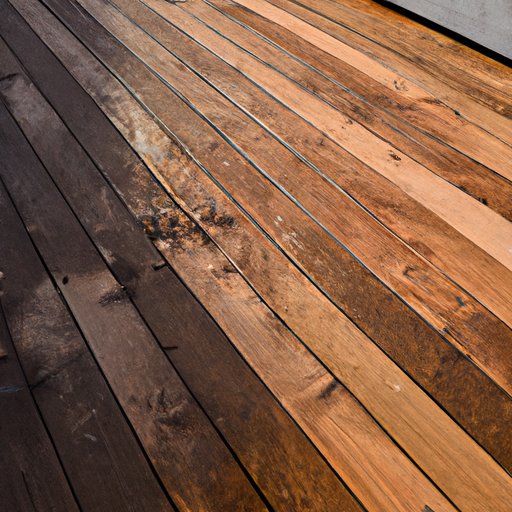Introduction
Untreated wood exposed to outdoor elements can quickly become damaged, discolored, and weakened. Unprotected wood is susceptible to water damage, rot, warping, cracking, and other issues. To ensure the longevity of a wooden structure or furniture piece outdoors, it is important to properly treat the wood to protect from moisture and UV rays.
This article will explore the various ways to treat untreated wood for outdoor use, including using a sealant, applying wood preservative, choosing hardwood species, pressure-treating wood, oiling the wood, staining the wood, and covering the wood. By following these steps, you can give your wood the protection it needs to last for years to come.
Use a Sealant
A sealant is an essential first step in protecting wood from moisture and UV rays. Sealants form a protective barrier on the surface of the wood that helps keep moisture out and also prevents fading and discoloration due to sun exposure. There are several types of sealants available, including clear coat sealers, varnishes, and polyurethanes.
Clear coat sealers are great for providing a glossy finish while still allowing the natural grain of the wood to show through. Varnishes offer more protection than clear coat sealers but can be harder to apply and may have a yellowish tint. Polyurethanes are the most durable type of sealant and provide excellent protection against water, UV rays, and other elements. However, they are also the most difficult to apply and can appear cloudy if not done correctly.
Apply Wood Preservative
Wood preservatives are a necessary step in treating wood for outdoor use. They penetrate deep into the wood to protect against decay, insects, and other pests. When selecting a wood preservative, look for one that is specifically designed for outdoor use and contains active ingredients such as borate, copper naphthenate, and permethrin. These ingredients help to repel insects and prevent fungal growth.
When applying the preservative, make sure to follow the manufacturer’s instructions carefully. It is important to wear protective clothing and safety gear when working with wood preservatives as they can be hazardous if inhaled or ingested.
Choose Hardwood Species
Choosing the right type of wood is essential when building something that will be exposed to the elements. Hardwood species such as oak, teak, and mahogany are more resistant to decay and insect damage than softer woods like pine and cedar. These hardwoods are also more durable and will last longer when exposed to the elements.
It is important to note that even hardwood species need to be treated for outdoor use. Applying a sealant and wood preservative will help to further protect the wood from water damage, rot, and other issues.
Pressure-Treat Wood
Pressure-treating wood is another way to protect it from water damage, rot, and other issues. This process involves forcing chemical preservatives deep into the wood fibers. The preservatives form a barrier that resists water and insects and also helps to prevent fungal growth.
When selecting a chemical preservative, look for one that is specifically designed for outdoor use and contains active ingredients such as borate, copper naphthenate, and permethrin. These ingredients help to repel insects and prevent fungal growth.
Oil the Wood
Oiling the wood is another way to protect it from water damage and rot. Oils penetrate deep into the wood fibers and help to repel water, preventing it from seeping in and causing damage. Oils also help to protect the wood from UV rays, preventing fading and discoloration.
When selecting an oil, look for one that is specifically designed for outdoor use and contains active ingredients such as tung oil, linseed oil, or mineral oil. These oils help to nourish the wood and protect it from water damage and UV rays.
Stain the Wood
Staining the wood is another way to protect it from water damage and rot. Stains penetrate deep into the wood fibers and help to repel water, preventing it from seeping in and causing damage. Stains also help to protect the wood from UV rays, preventing fading and discoloration.
When selecting a stain, look for one that is specifically designed for outdoor use and contains active ingredients such as linseed oil, tung oil, or mineral oil. These oils help to nourish the wood and protect it from water damage and UV rays.
Cover the Wood
Covering the wood is an important step in protecting it from water damage and rot. Tarps and other protective coverings can be used to shield the wood from rain, snow, and other elements. It is important to choose a material that is waterproof and breathable to allow moisture to escape without letting any in.
When selecting a tarp or other protective covering, look for one that is specifically designed for outdoor use. Also, make sure to choose a material that is lightweight and easy to install so you can easily cover and uncover the wood as needed.
Conclusion
In conclusion, treating untreated wood for outdoor use is essential for the longevity of a wooden structure or furniture piece. Using a sealant, applying wood preservative, choosing hardwood species, pressure-treating wood, oiling the wood, staining the wood, and covering the wood are all important steps in protecting wood from water damage, rot, warping, cracking, and other issues. Following these steps will help to ensure that your wood lasts for years to come.
If you are unsure about how to treat your wood for outdoor use, it is best to seek advice from a professional. A professional can help you select the right materials, tools, and techniques for your specific project.


